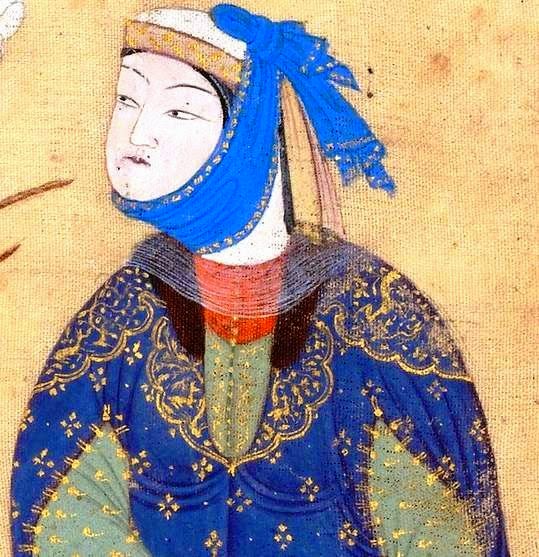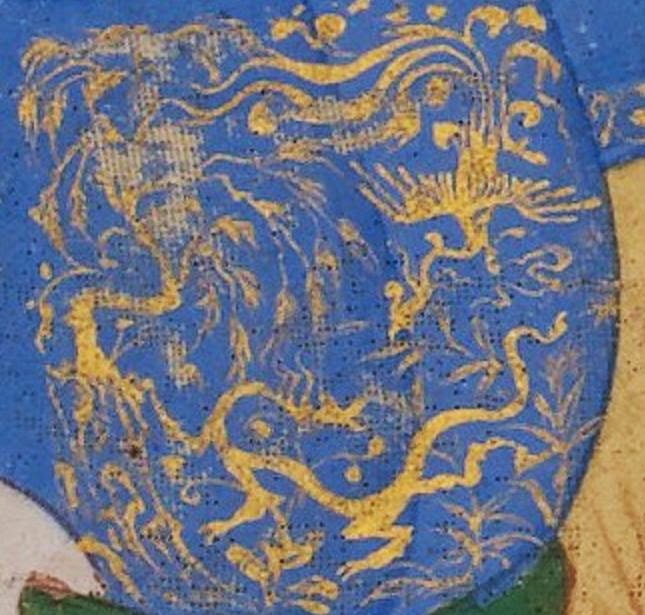Art was a way to gather and consolidate wealth to something transportable. Books and book paintings played an important role. they were tangible wealth, trade items and could be used as tribute to greater powers.
Here is an example of the Art of the Kara Koyunlu Turkmen :
 |
| Wine Drinking in a Spring Garden Kara Koyunlu Tabriz circa 1430 |
" it was common practice for Timurid artists to turn to Chinese models for pictorial inspiration. In this case, Chinese influence can be seen in the arrangement of figures on a horizontal groundline set against a neutral, undefined background; in the identity and sinuous style of the flowering prunus tree that braces the princess; and in the material used for the painting surface."
First of all reference to "Timurid artists" seems inappropriate. This piece shows every indication of a Tabriz provenance which points to the Kara Koyunlu Turkmen. If it were Shiraz then Ak Koyunlu Turkmen but to call the artist Timurid then Herat. But neither the Met nor I suggest Herat. Additionally when the Met suggests that a "Chinese influence can be seen in the arrangement of figures on a horizontal groundline" are we to take that to mean that a Turkmen artist copied from a Timurid artist or a Jalayirid artist who copied from a IL Khanid artist who was influenced by a Chinese artist. Or perhaps they feel the Tabriz school had direct access to Chinese paintings.
The clothes are fascinating. Note the Turkmen turban on the man and elegance of his gold embroidery. Add to that the very muted ermine collar on the woman's coat. It becomes clear that these two are royalty and they are flanked by their retainers.
By the way a Prunus is a family of trees and shrubs that includes the almond,apricot, cherry, nectarine, peach and plum trees.
Please note the tiny holes in the painting as if pricked repeatedly by a pin. This is because the painting is on silk cloth. I am intrigued by the hands of the women which show what I suspect may be Henna Tattoos. Note as well the writing in the tablet. later on we see messages or petitions in a painting. Perhaps we have that here.
Here we have the boots of the male attendant. Note the heels. This is a sign that the man was a Turkmen. This is a convention common in the 16th century that I believe holds true in the 15th as well. Compare to the boot heel in Farrukh Beg's The Turkmen Prisoner .
By the way a Prunus is a family of trees and shrubs that includes the almond,apricot, cherry, nectarine, peach and plum trees.
Please note the tiny holes in the painting as if pricked repeatedly by a pin. This is because the painting is on silk cloth. I am intrigued by the hands of the women which show what I suspect may be Henna Tattoos. Note as well the writing in the tablet. later on we see messages or petitions in a painting. Perhaps we have that here.
Here we have the boots of the male attendant. Note the heels. This is a sign that the man was a Turkmen. This is a convention common in the 16th century that I believe holds true in the 15th as well. Compare to the boot heel in Farrukh Beg's The Turkmen Prisoner .
The Prince's clothing show wonderful attention to detail and sophistication of technique. As does the female retainer's outfit below.
The simurgh and dragon square on the male retainer's garb strikes me as reminiscent of a Chinese Rank badge. Perhaps this is a vestige of the IL-Khanid court dress. As Kara Koyunlu Turkmen were earlier in their history vassals of the Jalayirids a late Mongol dynasty it is very possible.
Enlarged in image below.
Metropolitan Museum of Art
Wine Drinking in a Spring Garden
Illustrated album leaf
circa 1430 Iran, possibly Tabriz
Opaque watercolor and gold on undyed silk
8.5 in. high 30.20 in. wide (21.6 cm high 11.87 cm wide)
From the Cora Timken Burnett Collection of Persian Miniatures and Other Persian Art Objects, Bequest of Cora Timken Burnett, 1956.
Accession Number: 57.51.24
LABEL
The youth offering a cup of wine to a maiden reflects a Persian courtly ideal expressed in poetry as well as painting. But it was common practice for Timurid artists to turn to Chinese models for pictorial inspiration. In this case, Chinese influence can be seen in the arrangement of figures on a horizontal groundline set against a neutral, undefined background; in the identity and sinuous style of the flowering prunus tree that braces the princess; and in the material used for the painting surface.
N.B. Cora Timken Burnett was heir to the Timken Ball Bearing fortune and a noted artist in her own right.
Wine Drinking in a Spring Garden
Illustrated album leaf
circa 1430 Iran, possibly Tabriz
Opaque watercolor and gold on undyed silk
8.5 in. high 30.20 in. wide (21.6 cm high 11.87 cm wide)
From the Cora Timken Burnett Collection of Persian Miniatures and Other Persian Art Objects, Bequest of Cora Timken Burnett, 1956.
Accession Number: 57.51.24
LABEL
The youth offering a cup of wine to a maiden reflects a Persian courtly ideal expressed in poetry as well as painting. But it was common practice for Timurid artists to turn to Chinese models for pictorial inspiration. In this case, Chinese influence can be seen in the arrangement of figures on a horizontal groundline set against a neutral, undefined background; in the identity and sinuous style of the flowering prunus tree that braces the princess; and in the material used for the painting surface.
N.B. Cora Timken Burnett was heir to the Timken Ball Bearing fortune and a noted artist in her own right.








No comments:
Post a Comment